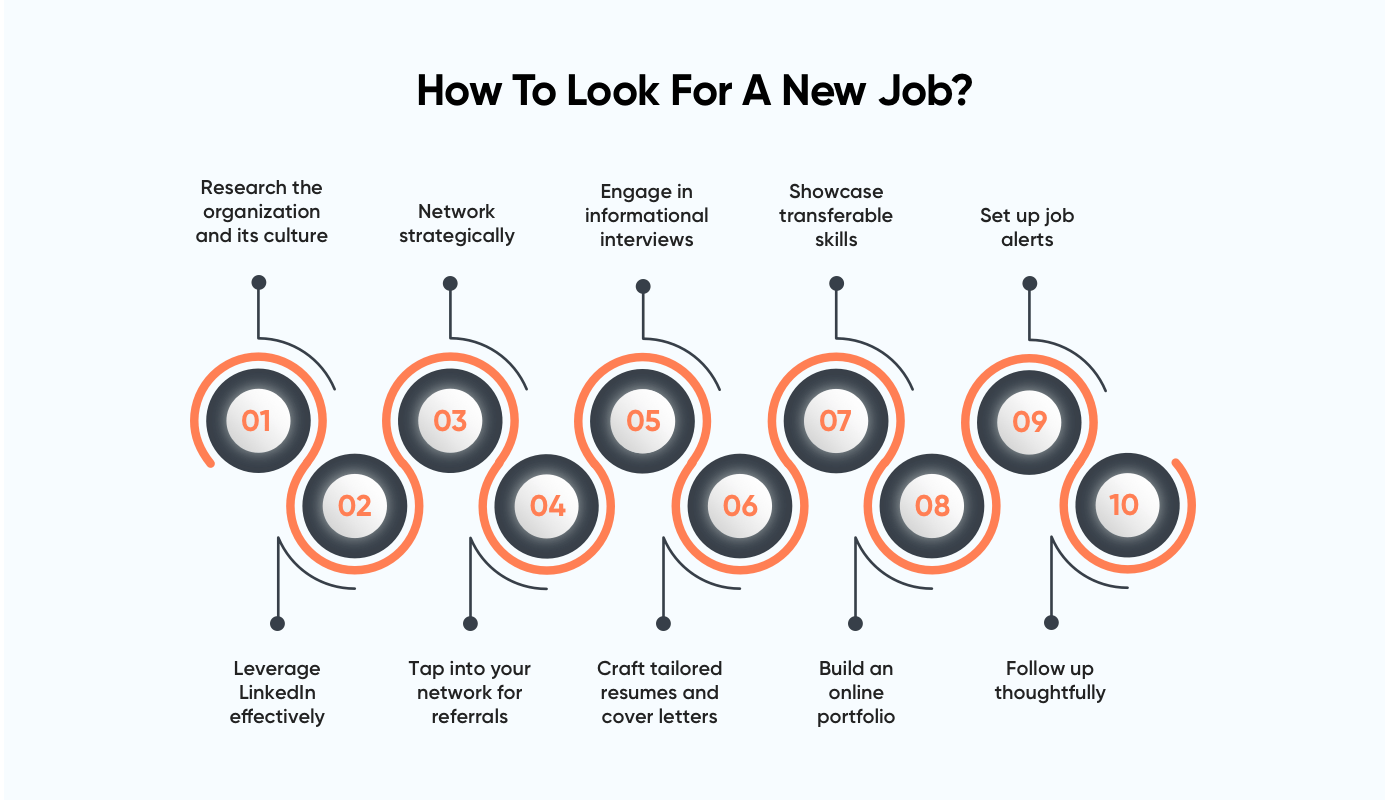Introduction
This article offers insights on how and where to find jobs, and the fundamental steps to get the job that aligns with their professional goals.
Some people remain stuck where they are to avoid the hassle of finding new jobs, even when they desperately want to leave.
No wonder there. Job searches can be overwhelming.
It was for me, and it's the same with most people I've encountered who went job searching.
The thrill of new opportunities, the uncertainty of the future, and the occasional rejection can do that to people.
In this article, I'll share practical strategies to help you find the job you want—that matches your aspirations, skills, and career goals.
- When to look for a new job?
- Why do you want a new job?
- Where to look for a new job?
- How to look for a new job?
- How do you deal with job rejection?
When To Start The Job Search?
You might've noticed that there are certain months when hiring booms.
And months when hiring freezes over. Radio silent.
So, it's important to know when to start the whole process. You don't want to begin looking for a job when all the positions have already been filled.
Be Mindful Of Hiring Patterns
Learn when companies in your industry and country usually start hiring. For instance, companies in the US usually start sharing their open positions from October to December according to the latest International Labor Organization report. In India, that happens from May to July after the start of a new fiscal in April.
Time Of Week
Job application activity peaks at the week's start, especially on Tuesday, making it strategic to send applications early in the week. Many positions receive hundreds of applications within 24-48 hours, and recruiters hit the pause button to process those first.
Avoid Holiday Seasons
If you've worked in an office, you know people look forward to holiday seasons to take time off work. Few companies would hire during those times. Post holidays, however, are a good time to send in your job application.
Why Do You Want A New Job?
Everyone looking for a job has a reason.
And it's imperative to know what your reason is so that you can select opportunities that align with your needs.
As Simon Sinek says, Start With Why.
Here are a few questions to help you understand your motives for seeking a new job.
- Professional growth: Are you seeking a new role to advance your skills and take on more challenging responsibilities?
- Values alignment: Are you looking for a workplace that better aligns with your personal values and professional aspirations?
- Work-life balance: Are you striving for a better work-life balance?
- Learning opportunities: Do you want to work where the organization invests in their people's learning and skills development?
- Company culture: Are you dissatisfied with your current organization's culture and would like to be a part of a more empowering workplace?
- Financial considerations: Are you primarily motivated by the potential for better financial growth and stability?
You may have reasons entirely different and specific to you.
However, knowing your reason(s) will increase the likelihood of finding a position that aligns with your goals.
You may also realize that you didn't want to change jobs and were only doing it because others were doing it, making you feel insecure and fearful.
Where To Look For A New Job?
There was a time when people would find jobs in newspapers and brochures.Thankfully, we've got better avenues to search for the jobs nowadays.
Here are some places you can look for a new job:
- Industry-specific job boards. Platforms like Indeed, Monster cater to various industries and have customizable search parameters. FlexJobs has postings for remote and flexible jobs. But I'd suggest starting with LinkedIn, as more recruiters and job seekers making a beeline to it. And you get all these cool insights into the job market, too.
- Attend industry conferences, webinars, and meet-ups to connect with professionals, build relationships, and stay informed about potential openings.
- Explore Best Place To Work companies from your industry to identify which companies you can apply for. You can always directly check out their open positions on their website and contact their recruiters via LinkedIn if you know what you're looking for.

How To Look For A New Job?
Once you know your reasons and have identified a few potential positions to target from your job search, it's time to apply for jobs.
This part, where you apply for jobs, requires a blend of digital finesse and real-world networking.

Research The Organization And Its Culture
Before applying or attending interviews, thoroughly research the company, its values, and workplace culture.
Explore the company's website, read recently published articles, and follow them on social media. Check Glassdoor reviews, too.
If something feels off, make points to clarify during the interview.
But if a lot seems off, you're better off not applying there. It will save you time and energy that can be better spent elsewhere.
You can also tailor your application according to their values. For instance, if the company values innovation and collaboration, tailor your application and interview responses to these cultural aspects.
Leverage LinkedIn Effectively
Most hiring managers look for candidates using LinkedIn.
Unlike most job search portals, LinkedIn allows you to contact recruiters directly.
Optimize your LinkedIn profile to showcase your skills, experiences, and career aspirations. You can take a course to learn how to do this.
Here are some steps you can take right away:
- Use the right keywords in your industry and job domain. Or the keywords for the job you're trying to get.
- Include a professional summary; write in the first-person narrative—that's how you own your story
- Use short, concise paragraphs and bullets to highlight key skills, accomplishments, and results
- Connect with professionals in your industry
- Join relevant groups and engage in discussions to expand your network
Network Strategically
Connect with people in your industry and the job roles you want to be in.
This step takes a continuous effort and genuine interest in people.
It's not a quick, immediate fix for when you need a job.
Your network will include people in your industry whose work and character you admire and learn from.
One way to identify the people you want to connect with, on LinkedIn or other socials, is to see where they work and what that work entails.
If you have applied to an organization or plan to apply, connect with your potential colleagues and have casual (with a hint of professional tone) conversations with them.
Ask them about the organization, their experience, and their work. Share your aspirations with them, too.

Tap Into Your Network for Referrals
Use your professional network—consisting of people you've connected with strategically—to seek referrals within their companies once you build a rapport.
If you have a connection at a company you admire, express your interest and inquire about potential opportunities.
Referrals often carry significant weight in the hiring process.
Plus, if the company has a referral program, the person referring you gets a bonus if you make it in. Quid pro quo done right.
Engage In Informational Interviews
An informational interview is a great way to gain insights and advice about your desired career path.
It's a friendly meeting with a professional, perhaps someone whose work you admire, to learn about career paths and work experiences.
Unlike a job interview, the focus is on gathering valuable information, expanding your network, and building relationships.
Requesting these interviews can lead to potential job opportunities and a better understanding of your desired field.
But not everyone would be willing to engage with you; be prepared for rejections and stalling.

Craft Tailored Resumes And Cover Letters
Recruiters and hiring managers usually spend a minute or less browsing a resume.
So you want to highlight your achievements, experience, and skills that align with the role you're applying for.
And make the resume as skimmable as possible.
Include facts and numbers to highlight the impact of your work in your past position.
For instance, if you were a web developer, highlight how your contributions increased the clients' website traffic, engagement and conversation rates, etc.
Showcase Transferable Skills
Transferable skills are applicable across various roles and industries. They are abilities and knowledge gained from past experiences that can be used in any job, such as time management, prioritizing, problem-solving, good verbal and written communication, etc.
These differ from core job skills, like coding for an engineer or accounting for a chartered accountant.
These skills show hiring managers that you're adaptable and versatile.
For example, if you're transitioning from a project management role in IT to a similar position in marketing, emphasize skills such as organization, communication, and the ability to meet deadlines.

Build An Online Portfolio
There are tons of websites that you can use to create your online portfolio.
Explore creative portfolios on Behance to get a reference.
Once you get a general idea, build a simple and elegant portfolio with Wix, Weebly, WordPress.com, or Cargo. And add your work that you're proud of.
It allows you to display your skills, experience, and accomplishments to potential clients or employers easily and effectively, anywhere in the world, anytime.
You can even include your portfolio link in your resume, guaranteeing a better interview chance.
For instance, graphic designers can display their designs, writers can feature published articles, and programmers can link to their GitHub repositories.
Set Up Job Alerts
Job portals and professional networks have this incredible system for job alerts.
Anytime a recruiter posts a job opening in your industry and interested domain, you get a notification on your chosen device.
To get the most out of this feature, set up your job alert with the right keywords, or else it can get annoying after a while.
For example, a software engineer would use keywords like Software Development, Programming, Coding, Web Development, Full Stack Development, Front-end Development, etc.
Here's how you can do it on LinkedIn.
Follow Up Thoughtfully
Not many people will send a thoughtful follow-up email after the interview.
If you feel that the organization you interviewed for is a place you can work in, write a follow-up email or drop a LinkedIn message to the hiring manager.
Don't make it too long or flowery. The goal is not to fawn over the person.
Express your gratitude for the opportunity and reaffirm your interest in the position by briefly highlighting how your skills and experience align with the company's needs.
That's sure to make you stand out in their mind.
How Do You Deal With Job Rejection?
Many people do not talk about the toll job searching can take on a person.
You can read Arzoo Tomer's story here, where she narrates her journey of dealing with interview rejection at Axelerant.

After tens of rejections, you might receive one or two job offers aligning with your goals.
These rejections eventually add up, creating self-doubt and a dent in confidence.
And when one internalizes rejections, their brain activates its threat response, releasing stress hormones like cortisol.
Here are some steps you can consciously take to protect your well-being and peace while searching for jobs:
Practice Self-Compassion And Self-Care
Recognize that job searching can be challenging. Be kind to yourself and celebrate small victories, like submitting a tailored resume or securing an informational interview.
And remember self-care, whether through exercise, mindfulness practices, or activities that bring you joy.
Create A Support System
Share your journey with friends, family, or mentors. Having a support system provides encouragement, insights, and a valuable outlet for expressing your thoughts and feelings.
Set Realistic Goals
Break down your job search into manageable goals. Don't target applying to 20 companies in one night.
Setting realistic and achievable milestones helps maintain motivation and prevents feelings of overwhelm.
Establish A Routine
Maintain a daily routine to provide structure and stability to the process.
Set a particular time for job searching activities within the day, as you'd probably have many other things to take care of—like your current job responsibilities!
A well-organized day keeps stress at bay.
Build Your Growth Mindset
A growth mindset allows you to view setbacks and rejections as opportunities for growth and realignment—instead of personal failures. But it does need some practice and reframing of our internal dialogue to see substantial results. Here is a video by psychologist Carol Dweck that explains this concept in more detail.
Finding a job that you deserve and aligns with your professional aspirations can be difficult.
But if you go at it with patience and the right strategy, you'll land the job you've always dreamed of.


Rohit Ganguly, Content Marketer
Rohit is a content marketer first and a YouTuber second. He loves to interact with animals, feed them, clean his apartment, and spend time with friends and family. Curious by nature, he also enjoys literature, movies, meditation, and calligraphy.

 We respect your privacy. Your information is safe.
We respect your privacy. Your information is safe.
Leave us a comment